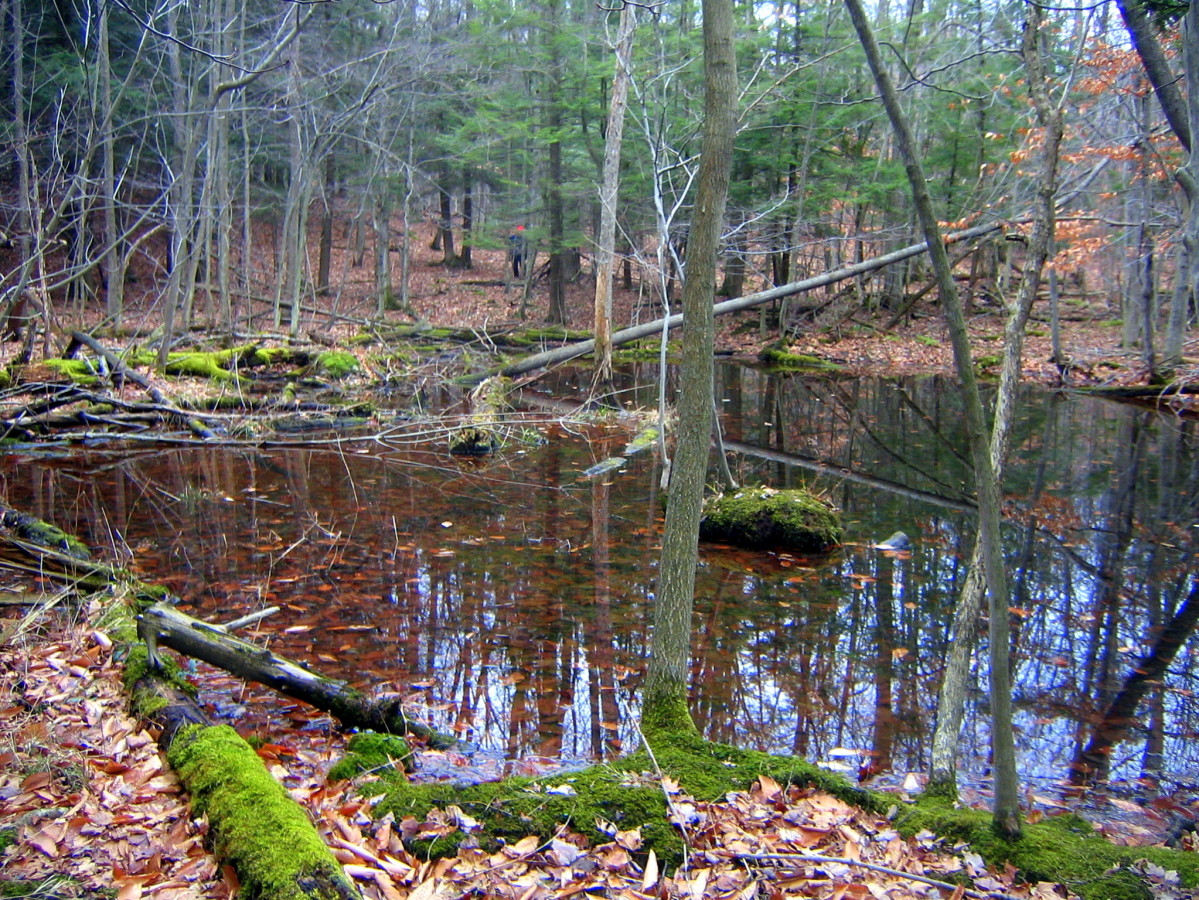Vernal pools, also known as woodland pools, are small (usually less than an acre), ephemeral wetlands found throughout the northern forests of the US and Canada, including our Finger Lakes region.
These shallow depressions fill with water in the spring and sometimes again in the fall, yet seem to disappear into the forest floor during the rest of the year.
Vernal pools may form when rain, wind, snow, glaciers or running water create gentle hollows in the earth. Pools in old-growth forests may also be formed by the trees themselves: when mature trees die naturally, they fall over and their root balls pull out of the ground, creating pits that may later fill with water. Before European settlement, the microtopography of our area was far more varied than it is today, and wetlands of all kinds, including vernal pools, were far more numerous. As generations of European settlers removed the forests, drained the wetlands, and plowed the land, the shallow depressions and slight mounds that characterized the primeval forest floor were flattened and in many cases disappeared altogether. Ironically, the same human activities that destroyed one ecosystem could create another: drainage ditches sometimes transform into vernal pools long after the original wetlands have disappeared.
It has been suggested that vernal pools are “keystone ecosystems”: that is, that their role in the landscape is larger than one would expect, given their small size. Vernal pools limit flooding downstream, recharge groundwater, reduce erosion, and serve as critical breeding, rearing and foraging habitats for many animals. Because they hold water only at certain times of the year, they cannot support fish and are therefore relatively safe nurseries for a number of species. Mole salamanders (named so due to their habit of burrowing), wood frogs and fairy shrimp are so-called obligate vernal pool species – in other words, they must breed in vernal pools. Other animals (such as the spring peeper, American toad, and spotted turtle) are known as facultative vernal pool species: they can use the pools for all or parts of their life cycles, but are not strictly dependant on them. The pools also provide foraging habitat for a wide range of other species, including turkeys, white-tailed deer, raccoons, mink, bats and raptors; wood ducks often nest by large vernal pools.
Despite their ecological importance, vernal pools have very little protection under either federal or state law. They are regularly destroyed, often unknowingly, by development, agriculture, off-road vehicle use and the introduction of invasive plants and animals. Well-meaning landowners may turn the seemingly useless “soggy” areas on their land into permanent ponds stocked with amphibian-eating fish. Perhaps because the number of suitable breeding habitats is in decline, the Jefferson salamander and the blue-spotted salamander – two obligate vernal pool species that are species of special concern in New York State – have begun to interbreed; non-hybrid individuals are increasingly rare. Even when vernal pools are not destroyed or altered, they are always at risk from contaminants. They generally fill with runoff and typically have small water volumes with high evaporation rates, and therefore they can accumulate high concentrations of pollutants.
Protecting vernal pools, however, is only part of the equation. It’s just as vital to preserve the land surrounding them, since species that breed in pools spend the remainders of their lifetimes in adjacent mature forests. On Long Island, marbled and tiger salamanders are threatened because developers, who are required to preserve vernal pools, build over the salamanders’ upland habitat instead. Another problem arises when man-made structures, such as roads, cut pools off from each other: isolated populations are more vulnerable to environmental changes and road traffic is devastating to migrating animals. Some species, such as the spotted turtle (another species of special concern in New York State), are especially vulnerable to road mortality because they lay very few eggs, mature very slowly and travel quite far in search of wetlands.
Although wetland ecosystems in the Finger Lakes have experienced much damage, there is a lot we can do to preserve and restore vernal pools as well as create new ones. Two local organizations that educate the public about vernal pools and are currently collecting data on the whereabouts of existing pools are The Upper Susquehanna Coalition at: http://www.u-s-c.org/html/vppage.htm and The Woodland Pool Steward Program at: http://www.dnr.cornell.edu/ext/woodlandpools/.


